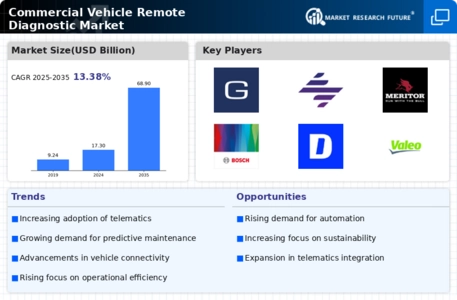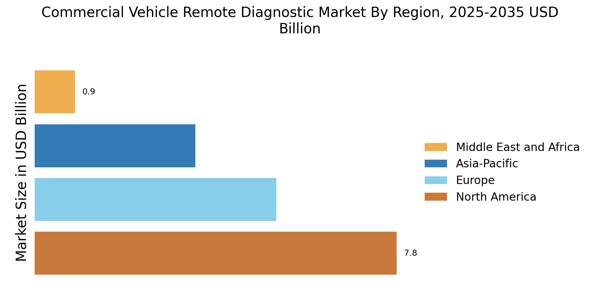Integration of Advanced Telematics
The integration of advanced telematics systems is a primary driver for the Commercial Vehicle Remote Diagnostic Market. These systems enable real-time monitoring of vehicle performance, allowing fleet managers to access critical data remotely. This capability enhances decision-making processes, as it provides insights into vehicle health, fuel efficiency, and driver behavior. According to recent data, the telematics market is projected to grow significantly, with estimates suggesting a compound annual growth rate of over 20% in the coming years. This growth is likely to propel the demand for remote diagnostic solutions, as businesses seek to optimize their operations and reduce downtime. Consequently, the Commercial Vehicle Remote Diagnostic Market is expected to benefit from this trend, as more companies adopt telematics to improve fleet management.
Growing Emphasis on Cost Efficiency
A growing emphasis on cost efficiency is driving the Commercial Vehicle Remote Diagnostic Market. Fleet operators are increasingly seeking ways to reduce operational expenses while maintaining high levels of service. Remote diagnostic tools offer the potential to identify issues before they escalate into costly repairs, thereby enhancing overall cost management. Industry analyses suggest that companies utilizing remote diagnostics can achieve savings of up to 25% on maintenance costs. This focus on cost efficiency is likely to encourage more businesses to adopt remote diagnostic solutions, as they seek to streamline operations and improve profitability. As a result, the Commercial Vehicle Remote Diagnostic Market is positioned for growth, driven by the need for enhanced cost management strategies.
Increased Focus on Safety Regulations
An increased focus on safety regulations is significantly impacting the Commercial Vehicle Remote Diagnostic Market. Governments and regulatory bodies are implementing stricter safety standards for commercial vehicles, necessitating the adoption of advanced diagnostic tools. These regulations aim to reduce accidents and enhance road safety, compelling fleet operators to invest in technologies that ensure compliance. The market for vehicle safety systems is expected to expand, with estimates suggesting a growth rate of around 15% annually. This regulatory environment is likely to drive the demand for remote diagnostic solutions, as they enable real-time monitoring of safety-related parameters. Consequently, the Commercial Vehicle Remote Diagnostic Market stands to benefit from the heightened emphasis on safety compliance.
Rising Demand for Predictive Maintenance
The rising demand for predictive maintenance is a crucial factor influencing the Commercial Vehicle Remote Diagnostic Market. As companies strive to minimize operational costs and enhance vehicle uptime, predictive maintenance solutions have gained traction. These solutions leverage data analytics and machine learning to forecast potential vehicle failures before they occur. Industry reports indicate that predictive maintenance can reduce maintenance costs by up to 30%, making it an attractive option for fleet operators. This trend is likely to drive the adoption of remote diagnostic tools, as they provide the necessary data for effective predictive maintenance strategies. As a result, the Commercial Vehicle Remote Diagnostic Market is poised for growth, as more businesses recognize the value of proactive maintenance approaches.
Technological Advancements in Vehicle Systems
Technological advancements in vehicle systems are a driving force behind the Commercial Vehicle Remote Diagnostic Market. Innovations such as electric and autonomous vehicles are reshaping the landscape of commercial transportation. These vehicles often come equipped with sophisticated diagnostic systems that require advanced remote monitoring capabilities. As the market for electric vehicles continues to grow, with projections indicating a substantial increase in adoption rates, the need for effective remote diagnostics becomes more pronounced. Fleet operators are likely to seek solutions that can seamlessly integrate with these new technologies, thereby enhancing operational efficiency. Thus, the Commercial Vehicle Remote Diagnostic Market is expected to experience growth as it adapts to the evolving technological landscape.


















Leave a Comment